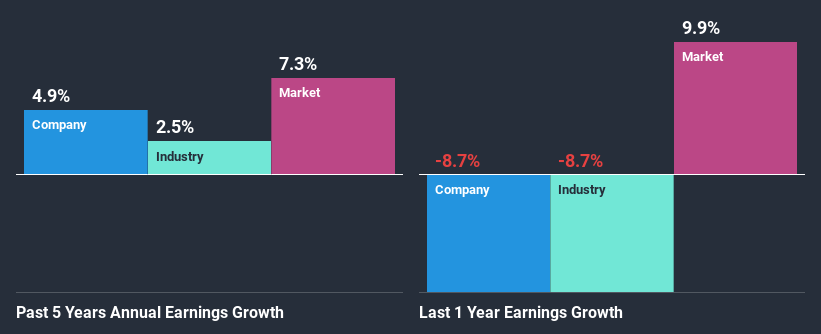Should Weakness in Port of Tauranga Limited's (NZSE:POT) Stock Be Seen As A Sign That Market Will Correct The Share Price Given Decent Financials?
Port of Tauranga (NZSE:POT) has had a rough three months with its share price down 1.9%. But if you pay close attention, you might find that its key financial indicators look quite decent, which could mean that the stock could potentially rise in the long-term given how markets usually reward more resilient long-term fundamentals. Particularly, we will be paying attention to Port of Tauranga's ROE today.
ROE or return on equity is a useful tool to assess how effectively a company can generate returns on the investment it received from its shareholders. In other words, it is a profitability ratio which measures the rate of return on the capital provided by the company's shareholders.
View our latest analysis for Port of Tauranga
How To Calculate Return On Equity?
ROE can be calculated by using the formula:
Return on Equity = Net Profit (from continuing operations) ÷ Shareholders' Equity
So, based on the above formula, the ROE for Port of Tauranga is:
7.8% = NZ$91m ÷ NZ$1.2b (Based on the trailing twelve months to December 2020).
The 'return' is the yearly profit. Another way to think of that is that for every NZ$1 worth of equity, the company was able to earn NZ$0.08 in profit.
What Is The Relationship Between ROE And Earnings Growth?
Thus far, we have learned that ROE measures how efficiently a company is generating its profits. Depending on how much of these profits the company reinvests or "retains", and how effectively it does so, we are then able to assess a company’s earnings growth potential. Assuming all else is equal, companies that have both a higher return on equity and higher profit retention are usually the ones that have a higher growth rate when compared to companies that don't have the same features.
A Side By Side comparison of Port of Tauranga's Earnings Growth And 7.8% ROE
At first glance, Port of Tauranga's ROE doesn't look very promising. However, the fact that the company's ROE is higher than the average industry ROE of 6.4%, is definitely interesting. However, Port of Tauranga's five year net income growth was quite low averaging at only 4.9%. Remember, the company's ROE is quite low to begin with, just that it is higher than the industry average. So that could be one of the factors that are causing earnings growth to stay low.
Next, on comparing with the industry net income growth, we found that Port of Tauranga's growth is quite high when compared to the industry average growth of 2.5% in the same period, which is great to see.
Earnings growth is an important metric to consider when valuing a stock. It’s important for an investor to know whether the market has priced in the company's expected earnings growth (or decline). This then helps them determine if the stock is placed for a bright or bleak future. If you're wondering about Port of Tauranga's's valuation, check out this gauge of its price-to-earnings ratio, as compared to its industry.
Is Port of Tauranga Efficiently Re-investing Its Profits?
With a high three-year median payout ratio of 90% (or a retention ratio of 9.5%), most of Port of Tauranga's profits are being paid to shareholders. This definitely contributes to the low earnings growth seen by the company.
Moreover, Port of Tauranga has been paying dividends for at least ten years or more suggesting that management must have perceived that the shareholders prefer dividends over earnings growth. Upon studying the latest analysts' consensus data, we found that the company is expected to keep paying out approximately 92% of its profits over the next three years. However, Port of Tauranga's ROE is predicted to rise to 9.8% despite there being no anticipated change in its payout ratio.
Summary
In total, it does look like Port of Tauranga has some positive aspects to its business. Specifically, its decent ROE which likely contributed to the growth in earnings. Bear in mind, the company reinvests little to none of its profits, which means that investors aren't necessarily reaping the full benefits of the decent rate of return. That being so, the latest analyst forecasts show that the company will continue to see an expansion in its earnings. Are these analysts expectations based on the broad expectations for the industry, or on the company's fundamentals? Click here to be taken to our analyst's forecasts page for the company.
This article by Simply Wall St is general in nature. It does not constitute a recommendation to buy or sell any stock, and does not take account of your objectives, or your financial situation. We aim to bring you long-term focused analysis driven by fundamental data. Note that our analysis may not factor in the latest price-sensitive company announcements or qualitative material. Simply Wall St has no position in any stocks mentioned.
Have feedback on this article? Concerned about the content? Get in touch with us directly. Alternatively, email editorial-team (at) simplywallst.com.

 Yahoo Finance
Yahoo Finance 
